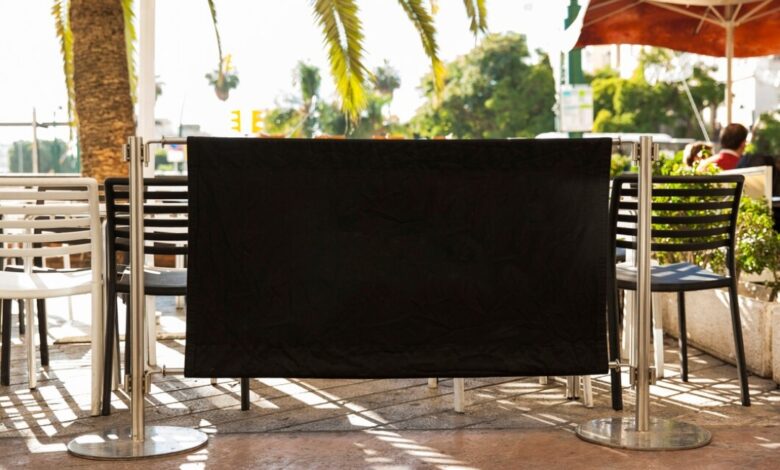Innovative Uses of Pavement Advertising Boards in Urban Settings

Pavement advertising boards, also known as sidewalk signs or A-frames, have become an integral part of urban marketing strategies.
Positioned strategically outside businesses, these boards effectively capture the attention of pedestrians and passersby, making them a versatile tool for enhancing visibility and driving foot traffic.
In this article, we explore the various innovative uses of pavement advertising boards in urban settings, highlighting their impact and best practices.
- Enhancing Visibility and Brand Awareness
Pavement advertising boards serve as powerful tools for increasing visibility and brand awareness in busy urban environments.
Placed strategically near storefronts or at key intersections, these boards attract attention from pedestrians and drivers alike.
They offer businesses the opportunity to showcase their brand logos, slogans, and promotional messages directly to potential customers.
- Directing Foot Traffic and Enhancing Customer Engagement
In urban settings where foot traffic can be dense and competitive, pavement advertising boards play a crucial role in directing potential customers into businesses.
They can be used strategically to highlight special offers, menu items, or upcoming events, prompting pedestrians to step inside.
Best Practices: Effective Call-to-Actions
- Clear and Concise Messaging: Use bold fonts and concise language to convey messages such as “Try Our New Menu,” “Happy Hour Specials,” or “Today’s Deals.”
- Eye-Catching Design: Incorporate vibrant colors and attractive visuals that align with the brand’s identity to grab attention amidst the urban hustle.
- Seasonal and Event-Specific Promotions
One of the innovative uses of pavement advertising boards is their adaptability to seasonal or event-specific promotions.
Businesses can easily update these boards to reflect current festivities, holidays, or local events, thereby staying relevant and appealing to the community.
Seasonal Adaptability
During the holiday season, retail stores often use pavement boards to promote seasonal sales or special gift ideas.
By incorporating festive decorations or themed graphics, these boards create a festive atmosphere that resonates with shoppers.
- Interactive and Digital Integration
With advancements in technology, pavement advertising boards are increasingly integrating digital and interactive elements to enhance engagement and interactivity with passersby.
This can include QR codes for instant access to online promotions, interactive touchscreens for browsing menus or product catalogs, or even LED displays for dynamic content.
Emerging Trends
- QR Code Integration: Restaurants and cafes use QR codes on pavement boards to link customers directly to their online ordering platforms or loyalty programs, offering convenience and incentives for immediate engagement.
- LED Displays: Some businesses opt for LED pavement boards that can display dynamic content such as videos, animations, or real-time updates on promotions, maximizing visibility and impact.
- Community Engagement and Local Partnerships
Beyond promotional purposes, pavement advertising boards can be leveraged to foster community engagement and support local initiatives.
Businesses can collaborate with neighborhood associations, local artists, or nonprofit organizations to create themed boards that promote community events, fundraisers, or cultural activities.
Community-Centric Approach
A local bookstore partners with nearby schools to display student artwork on their pavement boards, creating a rotating gallery that not only attracts families but also supports young talent and fosters community pride.
- Compliance and Sustainability Considerations
In urban settings, businesses must adhere to local regulations regarding the placement and design of pavement advertising boards.
These regulations often include guidelines on size, placement, safety, and environmental impact.
Additionally, businesses are increasingly opting for sustainable materials and practices when designing their boards to minimize ecological footprint and align with corporate social responsibility goals.
Compliance Checklist
- Permit Requirements: Obtain necessary permits or approvals from local authorities before placing pavement boards.
- Safety Measures: Ensure boards are stable and do not obstruct pedestrian pathways or create hazards.
Sustainability Practices
- Recyclable Materials: Choose boards made from recyclable materials or opt for digital alternatives to reduce waste and environmental impact.
- Adapting Messages to Local Trends
Pavement advertising boards provide businesses in urban settings with a dynamic platform to adapt their messaging according to seasonal trends and local events.
By regularly updating these boards with relevant and timely information, businesses can capture the attention of passersby and capitalize on seasonal consumer behaviors.
Timely Promotions
- Seasonal Offers: Promote seasonal products, services, or events such as summer sales, winter specials, or back-to-school promotions on pavement boards to attract targeted audiences.
- Event Announcements: Use boards to announce upcoming local events like festivals, parades, or community gatherings, creating anticipation and driving foot traffic.
- Building Partnerships for Mutual Benefit
In urban environments, pavement advertising boards can serve as a catalyst for collaboration between local businesses, organizations, and community groups.
By pooling resources and sharing board space, stakeholders can amplify their visibility, reach broader audiences, and cultivate a sense of solidarity within the community.
Collaborative Initiatives
- Cross-Promotions: Partner with neighboring businesses to cross-promote each other’s products or services on shared pavement boards, maximizing exposure and attracting diverse customer bases.
- Community Events: Collaborate with local nonprofits or cultural organizations to use pavement boards for promoting fundraising events, volunteer opportunities, or community initiatives.
Community Engagement
A bookstore collaborates with a nearby coffee shop to create a joint pavement board campaign promoting a book reading event followed by a coffee tasting session.
This collaboration not only enhances both businesses’ visibility but also fosters a sense of community among book lovers and coffee enthusiasts in the neighborhood.
Conclusion
Pavement advertising boards continue to evolve as dynamic tools for enhancing visibility, driving foot traffic, and fostering community engagement in urban settings.
By leveraging innovative strategies such as digital integration, seasonal promotions, and community partnerships, businesses can maximize the impact of these boards and create lasting impressions on their target audience.
As urban landscapes evolve, so too will the creative uses and effectiveness of pavement advertising boards in capturing attention and driving business growth.

